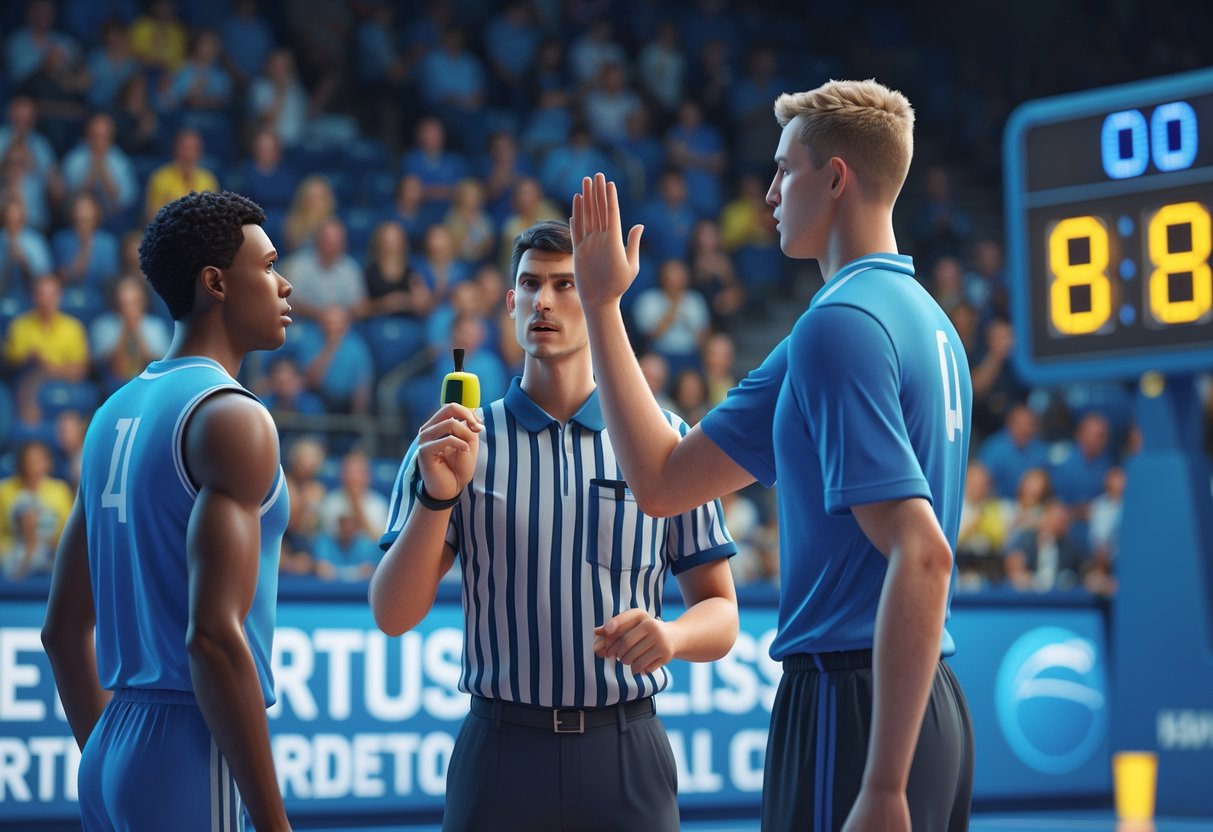Pause Rules Abuse: Understanding, Prevention, and Fair Play Online
Updated On: August 23, 2025 by Aaron Connolly
Defining Pause Rules Abuse

Pause rules abuse happens when players twist the intended purpose of game pause mechanics to get ahead unfairly in competitive gaming. It can look like manipulating timing systems or just messing with an opponent’s focus during those nail-biting moments.
What Constitutes Pause Abuse
Players cross the line when they use pause functions for more than technical hiccups. Sometimes, they pause to influence random events or even outcomes in the game.
Some folks hit pause over and over, throwing off the match’s flow. Others mess with timing mechanics that really should stay consistent.
You’ll see things like:
- Strategic pausing right as an opponent makes a big play
- Timing manipulation that resets random number generators
- Long pauses with no real technical reason
- Fake technical issues that just break someone’s concentration
Games have their own takes on what counts as a legit pause. In Portal 2 speedruns, pause abuse means using the pause to change event probabilities or pull off impossible actions.
Intent matters most here. If you’re pausing to fix a real problem, that’s fine. But if you’re pausing to get an edge, you’re abusing the system.
Common Methods of Exploitation
Players get creative with pause abuse. The classic move is timing manipulation at crucial moments.
A lot of people fake technical issues—claiming lag or hardware trouble just to pause strategically.
Some use pauses as psychological weapons, hoping to frustrate and distract the other side. It’s pretty annoying, honestly.
Other tactics target specific mechanics:
- Resetting random number generators
- Messing up animation timing
- Exploiting server sync issues
- Manipulating input buffers
Sometimes, teams coordinate elaborate “technical” excuses to justify long breaks when things aren’t going their way.
Speedrun communities have a tough time with this. Some runners pause to plan their next move or to mess with physics engines—stuff that wouldn’t fly in normal play.
Distinction Between Legitimate and Illegitimate Use
If you want to spot the difference between fair and abusive pausing, you’ve got to look at context and intent. Legit pauses fix real technical problems or follow tournament rules.
Legit reasons to pause:
- Actual hardware crashes
- Network drops
- Referee or official requests
- Medical emergencies
- Pre-approved tactical timeouts
Signs of abuse:
- Pausing when the opponent’s got the upper hand
- Too many pauses with no tech reason
- Suspiciously timed pauses during key plays
- Sudden gameplay improvements right after a pause
Tournament organizers lay down the law with clear rules. You’ll usually see limits on pause time, required explanations, and a need for ref approval.
Pro players have to be upfront—tell the ref and the other team why you’re pausing before you get back to the game.
Brief, honest pauses for real issues are fine. But if you keep pausing at just the right moments or play way better after a pause, people get suspicious fast.
Examples of Pause Abuse in Online and Competitive Games
Pause abuse pops up everywhere—speedrunners exploiting glitches, competitive players just trying to tilt their rivals. It messes with casual matches and high-stakes tournaments alike.
Speedrunning Communities and Game Glitches
Speedrunning groups face a special kind of pause abuse. Some games let players break the rules with clever pausing.
Take Pizza Tower for example. Players use “Assisted Extended Pause Abuse”—they pause on controller input, then unfocus the game window on the next frame. This move lets them mess with the game’s timing in ways the developers never planned.
In Minecraft speedrunning, strict pause rules exist for a reason. Runners need legit reasons for every pause. If someone keeps pausing and blames “real-life disturbance,” but their story doesn’t add up, moderators usually reject it.
Common speedrun pause abuse tricks:
- Frame-perfect timing exploits
- Messing with memory states
- Buffering inputs during pauses
- Using macros for endless pausing
Most speedrun communities now ask runners to explain their pauses. Pausing just to plan or do math? That’s not a technical issue, and it usually doesn’t fly.
Multiplayer Matches and Fair Play Disruption
Tactical pause abuse isn’t rare in competitive multiplayer games. Dota 2 pro matches have seen some infamous moments.
Remember the “Puppey Pause“? Puppey paused right before a gank, maybe warning his teammate in time to escape. That single pause probably changed the game’s outcome.
Other multiplayer pause abuse moves:
- Stopping play during enemy momentum
- Using the pause to peek at opponent items
- Messing up teamfight timing
- Playing mind games to stress out the other team
In Age of Empires, some players abuse macros to bypass the 10-pause limit. They just re-pause immediately after someone unpauses, ruining the match for everyone else.
Deadlock started banning people for this. Trolls would pause over and over for no reason, wasting everyone’s time and tanking match quality.
Impact on Timed Challenges
Timed competitions get hit hard by pause abuse. Players pause to buy themselves thinking time or shake off pressure when the heat’s on.
Tournament pause rules are all over the place:
- ESL says each team gets 10 minutes total
- StarLadder tried out 3-minute tactical pauses
- WESG only allows pauses for “accidents”
Online qualifiers see more abuse than LANs. Players claim “lag” during key moments. Organizers scramble to figure out who’s telling the truth and who’s just stalling.
Some events now white out screens during pauses. That way, teams can’t study opponent positions or item builds while the game’s stopped.
Marvel Contest of Champions wants 30-second inactivity timers. If you pause too long, you lose the match—no more endless stalling.
When pause abuse changes results in tournaments with million-pound prize pools, it’s no wonder people get frustrated. Every pause suddenly feels like a potential game-changer.
Consequences for Abusing Pause Rules

Gaming platforms and tournament organizers don’t mess around with pause rule violations. You might get banned from competition or even lose your account for good.
Disqualification from Leaderboards
Most games boot you off ranked ladders if you abuse pauses. In Deadlock, players who get reported for excessive pausing lose their seasonal ranks right away.
Tournaments can be even harsher. In Heroes of the Storm, teams caught pause trolling get default losses. You’re not just losing points—you’re out of the match.
Some games keep pause abuse records across seasons. Counter-Strike 2 tracks violations, and your trust factor drops if you keep breaking the rules. That means you’ll get matched with other troublemakers.
Tip: Check your conduct summary once in a while. Catch any pause warnings before things get worse.
Temporary or Permanent Player Bans
Game companies usually start with chat or pause feature bans, then ramp up if you keep it up. Valve, for example, gives a 24-hour feature suspension for a first offense.
If you keep breaking the rules:
- Second time: 7-day ban from features
- Third time: 30-day competitive ban
- Lots of reports: You could lose your account forever
The worst punishment? Hardware bans. Suddenly your whole computer can’t access the game, not just your account. Some Deadlock players say they got hit with these for chronic pause trolling.
Heads up: If you try making new accounts to dodge bans, you might get your whole IP blocked—nobody in your house can play.
Damage to Community Reputation
Pause abuse can trash your reputation in gaming circles. Discord servers and team recruiters keep lists of people to avoid.
If you get caught pause trolling, clips spread fast on Twitch or TikTok. Good luck finding a serious team after that.
Tournament organizers often share ban lists. If you get banned from one event, you might be out of others in the same game or region.
Esports scouts don’t want players with bad conduct records. Even if you’re super skilled, teams don’t want the drama.
Your Steam profile and in-game scores stick around for everyone to see. Every pause you make can stick with you for a long time. Is it really worth it for a quick advantage?
Detection and Reporting of Pause Abuse

Catching pause abuse takes a mix of automated tools, player reports, and careful review. Most platforms now use smart monitoring plus community moderation to spot problems fast.
Automated Monitoring Systems
Tournament platforms now track how often and when players pause. These systems flag weird patterns—like too many pauses or suspicious timing.
Important metrics:
- How many pauses per match
- Time gaps between pauses
- How long each pause lasts
- What players do during the pause
Most tournaments set hard limits. Usually, it’s 3 pauses per team and 5 minutes max each.
Some platforms even watch for spikes in chat during pauses. If a team suddenly starts talking a lot, they might be plotting, not fixing.
Organizers get alerts if someone crosses the line. Referees can then step in before a match gets ruined.
Player Reports and Moderation
Players still play a huge role in catching pause abuse. You can flag sketchy pauses right through most game menus.
For a good report, include:
- Exact times of the weird pauses
- What was happening in-game when it happened
- Any odd behavior during the pause
Most platforms handle reports in 24-48 hours during tournaments. If you keep getting reported, you’ll see bigger penalties.
Moderators look for patterns. If you always pause at the worst times for your opponents, you’ll get more attention than someone with the occasional tech issue.
Some games even reward good reports with in-game perks. That keeps the community invested in fair play.
Video Evidence and Review Processes
Tournament footage is gold for proving pause abuse. Most big matches get recorded from several angles, with audio too.
Reviewers look at:
- What players did just before pausing
- Team chat or voice during the pause
- The game state when the pause was called
- Whether the explanation matches the evidence
Pro tip: When reporting, give exact timestamps. You’ll help mods find the moment fast.
Live referees often watch big events. If they spot something fishy, they can step in right away.
Players can appeal penalties if they’ve got more evidence. Still, video proof usually settles things.
Preventing Pause Abuse through Rule Design

Good rule design keeps pause abuse in check while still allowing for real emergencies. The best systems use time limits and cooldowns to stop anyone from hijacking a match.
Setting Pause Limitations
Time restrictions stop players from dragging things out forever. Most games now limit individual pauses to 5-10 minutes tops.
Typical pause limits:
- Casual games: 2-5 minutes per pause
- Ranked matches: 5-10 minutes per pause
- Tournaments: 10-15 minutes, but only with a ref’s okay
Some games use a total pause budget for each team—maybe 15-20 minutes for the whole match. Once that’s gone, you’re out of pauses.
Voting systems help too. After a couple minutes, opponents can vote to unpause. That way, real tech issues get time, but abuse doesn’t last.
Warning messages at 75% of your pause time help you get ready. Clear countdowns show exactly how much time you’ve got left.
Cooldown Periods Between Pauses
Cooldown timers help stop people from spamming the pause button and ruining the flow of the game. Players usually have to wait 30-60 seconds before they can pause again.
Standard cooldown structures:
- First pause: No cooldown
- Second pause: Wait 30-45 seconds
- Third+ pause: Wait 60-90 seconds
Escalating penalties make things even stricter. Each extra pause in a match means you’ll wait longer. This setup lets real emergencies through but discourages anyone from abusing the system.
Some games reset cooldowns if you play for five or more minutes without pausing. So, if you don’t pause for a while, your timer goes back to zero.
Tournament modes usually disable cooldowns, but you need referee approval for every pause. This adds human oversight and keeps things fair.
Moderator and Community Strategies for Enforcement

Moderators have to communicate pause rules clearly and set up fair ways to handle disputes. Teams need a process to review decisions, and everyone should know what’s considered crossing the line.
Clear Communication of Rules
Moderators should explain pause rules before tournaments even start. A lot of new esports viewers don’t really get why tactical pauses matter or when they count as abuse.
Essential Communication Methods:
- Pre-match briefings that lay out pause limits and penalties
- Visual overlays showing pause time left during streams
- Chat commands that show current pause rules to viewers
- Social media posts to highlight rule changes between seasons
Tournament organisers need to post pause policies on their websites. Players sometimes lose matches just because they didn’t know the exact rules.
Quick win: Make a simple infographic showing good vs bad pause reasons. Share it on Discord and team chats.
Moderators have to announce decisions right away. If they flag a pause as abuse, viewers need to know why. If they don’t explain, people start accusing them of bias.
Fair Appeal and Review Procedures
We need systems that let players explain pause violations. Sometimes emergencies or technical issues happen, and players deserve a chance to clarify.
Essential Appeal Components:
| Review Stage | Timeline | Evidence Required |
|---|---|---|
| Initial Report | 24 hours | Match footage, timestamps |
| Formal Appeal | 72 hours | Technical logs, witness statements |
| Final Decision | 1 week | Complete case review |
Tournament staff should log every pause with timestamps. This helps show the difference between real technical problems and tactical abuse.
Warning: A lot of tournaments don’t have proper appeal systems. Players sometimes get penalized without a chance to explain what actually happened.
Appeal panels should include people who weren’t part of the original decision. This helps avoid conflicts of interest and keeps things fair.
Quick appeals are better than long, drawn-out ones. Players need answers before their next match—not weeks later, when it’s too late.
Impact of Pause Abuse on Player Experience

When players misuse pause functions, the whole community feels it. It hurts individual matches and can sour the entire competitive scene.
Frustration and Loss of Trust
Pause abuse drives people away from competitive gaming. One study found that one in twenty games gets spam-paused for minutes at a time, with no real reason.
Players feel helpless when others abuse pause systems. The most common complaints?
- Momentum disruption – tactical pauses break up exciting plays
- Time wasting – fake technical issues drag matches out
- Psychological manipulation – pauses used to mess with opponents’ heads
Trust falls apart fast if no one enforces pause rules. New players often quit after running into this a few times.
The unpause system brings its own headaches. Players who need a real break sometimes watch opponents unpause out of spite.
Distortion of Competitive Balance
Pause abuse changes how games play out. Pro tournaments have seen teams use “technical difficulties” as a cover for strategy talks.
The Puppey pause incident in Dota 2 showed how a pause can swing a match. Players got unfair advantages by checking gear or repositioning during suspicious breaks.
Timing becomes weaponised in these situations:
| Abuse Type | Impact | Example |
|---|---|---|
| Pre-fight pauses | Breaks opponent momentum | Pausing before enemy team attacks |
| Item checking | Unfair information advantage | Viewing opponent inventory during pause |
| Team coordination | Extra strategy time | Discussing tactics mid-engagement |
Tournament organisers often can’t keep up. Proving intent is tough without team comms, so lots of abuse goes unpunished.
Casual players deal with the same stuff. Ranked matches can turn into a contest of who abuses the pause system best.
Case Studies of Pause Rules Abuse

Some high-profile incidents have shown just how easily people can abuse pause rules. These cases pushed major esports organisations to change their policies.
Notable Incidents in Esports
One of the most talked-about cases happened at a Counter-Strike: Global Offensive tournament in 2019. Team Alpha called a tactical pause, claiming technical issues, but used the time to talk strategy after spotting their opponents’ setup.
Video later caught the team leader signaling new tactics with hand gestures. The pause dragged on for eight minutes when it should’ve lasted two.
Another time, in a League of Legends match, a player said their mouse was broken. The pause let their coach walk in and give advice about enemy positions. Officials didn’t catch this right away.
In Dota 2, a team called several quick pauses during key fights. Each one broke their opponents’ focus. The defending team lost their edge and made mistakes after the interruptions.
Community Responses and Policy Updates
After these incidents, organisers tightened pause protocols. Most now demand video proof before allowing technical pauses. Officials have to approve equipment issues within 30 seconds.
Many leagues rolled out penalty systems for abuse. First-time offenders get warnings, while repeat abusers can lose rounds or even get kicked out.
The community started tracking suspicious patterns on social media. Fans documented weird pause timing and frequency, which helped spot more abuse.
New rules now limit coaching communication during pauses. Coaches and players get separated by barriers, and officials keep an eye on everything.
Differences Across Gaming Platforms and Genres

Pause rule abuse looks different depending on the game and the environment. Speedrunning, for example, has its own issues compared to casual single-player games.
Single Player Versus Multiplayer Dynamics
Single-player games are way more relaxed about pausing. You can hit pause anytime, and it only affects your experience.
Common single-player pause habits:
- Saving before tough spots
- Pausing to look up guides
- Taking breaks during timed parts
- Planning moves on the pause screen
Most communities don’t care about this in solo play. You’re only impacting yourself, so why not?
Multiplayer games are another story:
- Some allow tactical pauses
- Others ban pausing completely
- Tournaments often restrict it
- Some players force pauses by faking connection issues
Fighting games like Street Fighter give you a quick pause but punish you if you overdo it. RTS games let you pause casually but not in ranked matches.
Speedrunning Versus Casual Play
Speedrunning groups have the toughest pause rules. Every second matters when you’re chasing records.
Most speedrunning categories ban:
- Pausing during gameplay
- Using pause screens to plan
- Taking breaks mid-run
- Looking up info while paused
Different categories handle pauses their own way:
- Any% runs usually ban all pauses
- 100% runs might allow quick breaks
- Tool-assisted runs allow frame-by-frame pausing
- Casual runs are more relaxed
Casual players have it easier. Most communities get that life happens during games.
Typical casual pause reasons:
- Answering calls
- Family interruptions
- Bathroom breaks
- Grabbing food during long sessions
The big difference? Competition versus entertainment.
Alternative Approaches and Solutions

Fixing pause rule abuse takes both smart tech and better player education. The best solutions use automated tools to spot weird patterns and community programs to teach good habits.
Automated Pause Management Tools
Game developers now use advanced systems to catch pause abuse. These tools track when, how often, and why players pause during matches.
Machine Learning Detection Systems look at player behavior over lots of games. They flag accounts that always pause at sketchy moments, like right before an opponent scores.
Most big esports platforms now use progressive penalties. First-time offenders get warnings. If they keep it up, they get temporary bans or lose rank.
Real-time monitoring tools catch coordinated pause abuse in team games. If several teammates keep pausing, the system flags them for review.
Games like Dota 2 and CS2 now limit how long you can pause and require the whole team to agree for extensions. This stops one player from holding everyone hostage.
Education and Awareness Initiatives
Teaching players about pause etiquette is just as important as punishing abuse. A lot of people break the rules simply because they don’t realize the impact on others.
Community education programmes in schools and gaming centers talk about competitive integrity. They cover when it’s okay to pause and why abuse hurts everyone.
Gaming groups team up with streamers and pros to show good sportsmanship. When popular players set the right example, others usually follow.
In-game tutorials now cover pause rules along with basic mechanics. New players pick up good habits early.
Tournament organisers regularly post clear guidelines about pausing. These documents spell out what’s allowed and what happens if you break the rules.
Ethical Considerations and Sportsmanship

When we talk about pause rule abuse in esports, we’re really talking about a breakdown of the values that keep competitive gaming fair and fun.
Fair play is the backbone of ethical esports. That means respecting the rules, your opponents, and the officials—even when no one’s watching.
Core Principles of Ethical Esports
The basics we should stick to:
- Honesty in every situation
- Respect for opponents and officials
- Integrity during matches and practice
- Graciousness win or lose
Abusing pause rules breaks these principles. If you fake technical issues or misuse timeouts, you’re picking short-term gain over long-term trust.
The Real Impact on Competitive Gaming
Poor sportsmanship doesn’t just mess up one match. It breaks trust between teams, frustrates organisers, and makes the whole scene look bad.
A lot of semi-pro players say that seeing others bend the rules makes them feel pressure to do the same.
| Ethical Behaviour | Impact on Esports |
|---|---|
| Following pause rules | Keeps matches fair and flowing |
| Respecting others’ time | Builds respect all around |
| Honest communication | Builds trust in the system |
Quick win: Assume referees and opponents will catch dishonest tactics—they usually do.
Esports credibility depends on players showing the same ethical standards as any traditional sport. If we abuse pause rules, we’re just hurting the legitimacy that competitive gaming has spent years building.
Future Trends in Preventing Pause Rules Abuse

Enhanced automated monitoring systems are quickly becoming the main defense against pause rule manipulation in competitive gaming.
These AI-powered tools spot unusual patterns and block players from taking advantage of technical breaks.
Tournament organizers now roll out stricter verification protocols before they even allow a gameplay interruption.
Players have to provide immediate proof of technical issues, and they need to do it fast—often through several channels at once.
Real-time adjudication panels are taking over from single referees.
A group of officials now reviews pause requests instantly, which really cuts down on bias and keeps things fair across all matches.
| Prevention Method | Implementation Timeline | Effectiveness Rating |
|---|---|---|
| Automated detection | 2025-2026 | High |
| Multi-official review | Currently rolling out | Medium-High |
| Hardware monitoring | 2026+ | Very High |
Hardware-level monitoring is the next big leap.
Tournament PCs automatically log system performance, so it’s nearly impossible to fake technical problems now.
We’re also seeing standardised penalty frameworks pop up across the biggest leagues.
Clear consequences for pause abuse are finally scaring off most attempts at strategic manipulation.
Player education programmes are really picking up speed.
Teams now have to go through required training on proper pause procedures and learn about the real risks of breaking the rules.
Community reporting systems let spectators and players flag anything suspicious.
This crowdsourced approach often catches subtle abuse that officials might overlook.
The arrival of blockchain-based match logs is a game changer.
These records are tamper-proof, making it impossible to dispute when and why a pause happened.
Frequently Asked Questions

Players still get confused about pause rule violations and what’s considered good etiquette in online competition.
Knowing these boundaries helps keep things fair and avoids penalties that could mess up your competitive reputation.
What constitutes an abuse of the pause function in online gaming?
Pause abuse happens when players use the pause feature to gain unfair advantages instead of for real issues.
Common violations? Pausing just to disrupt your opponent’s momentum during key moments.
Some players keep pausing to break their opponent’s focus.
Others use that time to talk with teammates, especially when voice chat isn’t allowed.
Tactical pausing right before a big fight or round is also considered abuse.
A lot of games call this unsportsmanlike conduct and say it violates competitive integrity.
Faking technical issues is another classic move.
Players claim internet or hardware problems just to buy time for extra strategy talks.
How can players effectively report instances of pause mechanism misuse?
Most competitive games have built-in reporting systems right in the match interface.
Look for report buttons in the scoreboard or pause menu during games.
Try to document specific instances with timestamps.
Note how many times your opponent paused and whether their reasons made sense.
Many platforms like Steam or console networks offer separate reporting channels.
It’s smart to file reports through both the game client and the platform itself.
Tournament organizers sometimes accept reports through official Discord servers or support tickets.
Always check the competition rules for reporting steps before your match.
Screenshot evidence can really help your case.
Grab pause notifications and chat messages that show a pattern of abuse.
What are the common penalties for players who repeatedly misuse game pause features?
First-time offenders usually get warnings or a short matchmaking ban.
These bans might last anywhere from 30 minutes to a few hours, depending on how bad the violation was.
Repeat offenders face longer suspensions—sometimes days or even weeks.
Your account could lose access to ranked modes or competitive playlists.
Tournament play is a whole different story.
You could forfeit a match or get kicked out of the event entirely.
Serious violations mean prize money and ranking points get taken away.
Some games use escalating penalty systems that track your history.
Each new offense brings longer punishments.
Platform-level bans can hit your whole gaming account.
A Steam or console suspension might block you from online features across several games.
Could you explain the proper etiquette for using pause in competitive online matches?
Always announce your reason for pausing in team or all chat before you actually hit pause.
Valid reasons? Technical issues, emergency calls, or real hardware problems.
Keep pauses short to respect everyone’s time.
Most communities expect pauses to be under two minutes unless something major happens.
Ask your opponents for permission when you can, especially in unofficial matches or scrims.
This small gesture goes a long way in keeping relationships positive in the scene.
Try not to pause during active combat or crucial moments unless it’s a real emergency.
Wait for natural breaks between rounds or during respawn times if possible.
Thank the other players for waiting once you’re back.
It’s just good manners to acknowledge the disruption and show some appreciation.
What steps are game developers taking to prevent the manipulation of pause rules?
A lot of developers now limit pause duration to stop long delays.
Games like CS2 and Valorant cap pause time at set intervals for each team per match.
Automatic tracking systems keep an eye on pause patterns across player accounts.
Algorithms flag suspicious behavior like frequent pausing when the other team has an advantage.
Some games use vote systems that require team consensus to pause.
This stops one player from disrupting the match for everyone else.
Tournament modes often restrict pause privileges to certain players or officials.
Usually, only team captains or referees can pause during big events.
Machine learning systems now analyze pause timing compared to game states.
Developers can flag players who always seem to pause at the worst possible moments for their opponents.
Is there a limit to the number of times a player can pause a game, and how is it regulated?
Most competitive games set strict pause limits for each team during a match. Usually, you’ll see 2-4 pauses allowed, each lasting anywhere from 30 seconds up to 2 minutes.
Valve’s Counter-Strike, for example, gives each team one tactical timeout. Teams can also use a few quick technical pauses. If a team tries to pause too often, they lose the right to pause again.
Riot Games takes a different approach depending on the title. Valorant lets teams use technical pauses, but in League of Legends, you can only pause during tournaments.
Automated systems keep an eye on pause usage in real-time. If someone goes over the limit, the system will send a warning, then just turn off the pause option completely.
Tournament organizers sometimes get even stricter than the game’s built-in rules. In pro matches, you’ll often need a referee’s approval before you can pause at all.

